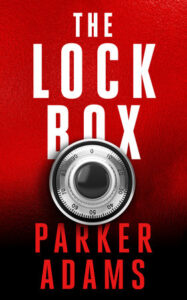When people ask what kind of books I write—especially people who are obviously younger than me—I catch myself biting my tongue at the instinctive response. Tell someone that you’re a “technothriller author” and you’ll get a sideways glance. The same reaction I imagine you’d receive if you said you were a landline phone repairman, or a dodo bird watcher.
Raised eyebrows. Scrunched eyes.
“Is that actually a thing?”
The question is valid. Walk into a bookstore today and you’ll find shelves divided into more nuanced categories than ever. Domestic thrillers. YA. Paranormal fiction. But not technothrillers. Former biologists (like me) might say that it seems they’ve gone…extinct.
That’s quite a shift from the world I grew up in. In 1984, at the peak of the Cold War, an unknown author with thick glasses and a baseball cap released a book through the Naval Institute Press about a missing Russian nuclear submarine. In many ways, Tom Clancy’s The Hunt for Red October was a typical page-turner: plucky-but-underappreciated analyst Jack Ryan winds up in a breakneck race to prevent worldwide disaster. But what made The Hunt for Red October different—what made it special—was Clancy’s focus on the submarine. Page after page was devoted to explaining how submarines worked, how they navigated the complex topology of the ocean floor, and how this particular sub had been engineered to run silent and deep.
Within months, The Hunt for Red October became a national phenomenon. After President Reagan called it “my kind of yarn,” it shot to the top of the bestseller lists, selling over 4 million copies.
And with that success, a new category was born.
Clancy wrote 18 more novels, 17 of which became bestsellers. Within five years, his stories were being adapted into films featuring the biggest stars and directors of the day. The Hunt for Red October’s cast included James Bond (Sean Connery) and Darth Vader (James Earl Jones), directed by the man who’d helmed Die Hard (John McTiernan). 1992’s Patriot Games starred the undisputed king of action films, Harrison Ford.
The technothriller craze became bigger than just Clancy, though. In particular, it ballooned thanks to another superstar author, a lanky, Harvard-trained M.D. who’d been writing novels for 15 years before The Hunt for Red October was published. You could argue that Michael Crichton beat Tom Clancy to the punch and invented the technothriller with books like The Andromeda Strain (1969), The Terminal Man (1972), and Congo (1980). All of those featured breathless pacing combined with credible technology hooks thanks to Crichton’s science chops. But while Crichton had hit the bestseller list, he wasn’t quite the household name Clancy was…until a certain book about dinosaurs.
Jurassic Park hit shelves in 1990, the same year The Hunt for Red October hit movie screens. Like Crichton’s previous works, it featured the promethean theme of humanity threatening its own existence by creating or unearthing something uncontrollable. It contained Crichton’s typical, meticulous research on cloning and DNA extraction, distilled down in a way that was approachable to lay readers. And it had dinosaurs—lots and lots of dinosaurs. Species readers knew well, like Tyrannosaurus rex, but also new ones, like velociraptor. The book even contained the then-fledgling idea that, instead of disappearing completely, dinosaurs had morphed through evolution into modern birds.
Given how prehistoric creatures can capture the imagination, it wasn’t long before Jaws director Steven Spielberg gobbled up the rights to Jurassic Park and delivered us the CGI moment/meme of Laura Dern and Sam Neill standing up in their Jeep at the sight of a living, breathing brontosaurus.
From there, Clancy and Crichton seized a vicelike grip on entertainment. Clancy’s universe birthed more movies, then videogames. Meanwhile Crichton continued pumping out books and movies himself, while also conquering television. Through the blockbuster ER, Crichton introduced an entire generation to medical terminology like “CBC,” “Chem 7,” and “stat!” By 2000, it seemed the technothriller would be with us forever.
But a funny thing happened in aughts: people stopped talking about technothrillers so much. Maybe it was a natural letdown after the futuristic-sounding turn of the millennium. Or, as technology became increasingly prevalent in our everyday lives—as the Internet became pervasive and smartphones grew ubiquitous—maybe society as a whole wasn’t as impressed by glimpses of the near-future. It certainly didn’t help that the genre’s two leading lights also left us. Crichton died in 2008 and Clancy followed five years later (both at the age of 66—how about that for an odd coincidence?).
Just last year though, after a decade-plus, publishing appeared to have its own seeing-the-brontosaurus moment. First, the trades announced that James Patterson would be finishing Michael Crichton’s final manuscript, Eruption. When the mainstream press caught word, they cooed that the book would be the “biggest thriller of 2024.” Everywhere, it seemed, was the news that the technothriller had returned! At last!
Except…the technothriller never died. It never even went away.
Like dinosaurs, cloaked in feathers as birds, technothrillers have been hiding in plain sight this whole time.
Take James Rollins. While he may not have the name recognition of a Tom Clancy or a Michael Crichton, he’s been more prolific than either of them—31 books and counting—and is a perennial bestseller. Having practiced for years as a veterinarian, he brings the same kind of scientific background to his novels that Crichton did, but he happens to mix those techno-elements with bits of fantasy and mysticism. Straddling that line may be why Rollins has never been expressly crowned as the heir to Clancy and Crichton.
The Clancy estate has also continued publishing books, with other authors like Marc Cameron, Mark Greaney, and Andrews & Wilson taking up the Jack Ryan mantle. Although these books typically get branded as “military fiction,” they carry on Clancy’s tradition of delving deep into the high-tech aspects of modern warfare. For example, Don Bentley drew extensive applause for the way he wove hypersonic aircraft into the plot of his most recent entry in the Clancy-verse, 2023’s Weapons Grade.
Although Andy Weir’s work is deemed science fiction, his novel The Martian and its eventual film adaptation are unquestionably Crichton-esque technothrillers. Indeed, the scientific tricks botanist Mark Watney uses to survive on Mars and communicate back to Earth are more grounded in reality than several of Crichton’s plots; they just happen to play out in outer space rather than in Africa (Congo) or underwater (Sphere).
Another author who defies today’s categorization schemes is Blake Crouch—I have seen his books listed among science fiction, psychological fiction, horror, and mystery. But the niche he most seamlessly fits into is technothriller. Whether taking on quantum mechanics in Dark Matter or the neuroscience of memory in Recursion, Crouch has proven extremely adept at blending approachable discussions of difficult technology with mind-bending plots that keep the pages turning late into the night.
Having followed all of these authors’ careers closely—indeed, having tried to emulate them with my own Seth Walker series, and now The Lock Box—I have never worried about the future of tehcnothrillers. The genre is alive and well, thriving in their talented hands.
But, like everyone else, I can’t wait to read Eruption.
***


















